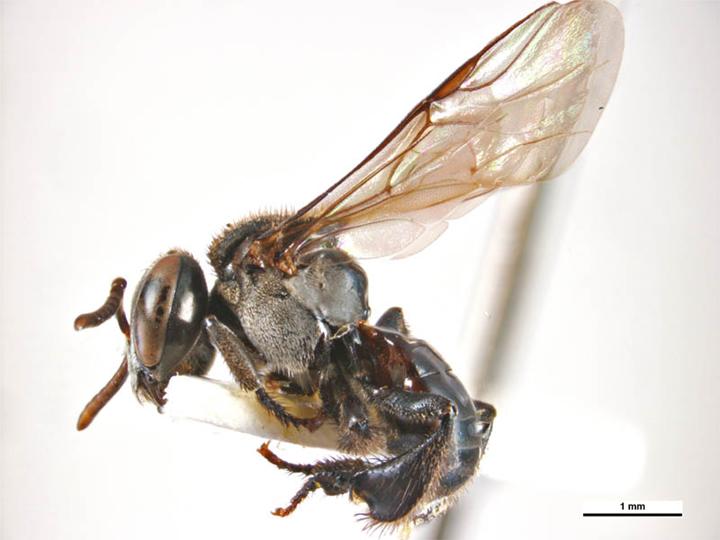|
Tetragonula Mellipes
''Tetragonula mellipes'' is a small eusocial stingless bee Stingless bees, sometimes called stingless honey bees or simply meliponines, are a large group of bees (about 550 described species), comprising the tribe Meliponini (or subtribe Meliponina according to other authors). They belong in the family ... first described by Friese in 1898 and it is found in Northern Australia (Northern areas of Western Australia and Northern Territory). Description and identification The workers (3.6-4.3mm) are pale brown with sides of the thorax (Mesopleuron and metapleuron) densely and evenly covered with fine, short hair. Male drone body colour is very similar to the workers. ''T. mellipes'' is distinctly smaller than the sympatric '' T. hockingsi'' in most characters. However, it is similar to the apparently allopatric '' T. carbonaria'', except it has shorter wings. Furthermore, when alive, the eyes are paler in colour compared to the darker eyes of '' T. carbonaria'' and T. ''hocki ... [...More Info...] [...Related Items...] OR: [Wikipedia] [Google] [Baidu] |
Eusociality
Eusociality (from Ancient Greek, Greek εὖ ''eu'' "good" and social), the highest level of organization of sociality, is defined by the following characteristics: cooperative Offspring, brood care (including care of offspring from other individuals), overlapping generations within a colony of adults, and a division of labor into reproductive and non-reproductive groups. The division of labor creates specialized behavioral groups within an animal society which are sometimes referred to as 'castes'. Eusociality is distinguished from all other social systems because individuals of at least one caste usually lose the ability to perform at least one behavior characteristic of individuals in another caste. Eusocial colonies can be viewed as superorganisms. Eusociality exists in certain insects, crustaceans, and mammals. It is mostly observed and studied in the Hymenoptera (ants, bees, and wasps) and in Blattodea (termites). A colony has caste differences: queens and reproductive males ... [...More Info...] [...Related Items...] OR: [Wikipedia] [Google] [Baidu] |
Stingless Bee
Stingless bees, sometimes called stingless honey bees or simply meliponines, are a large group of bees (about 550 described species), comprising the tribe Meliponini (or subtribe Meliponina according to other authors). They belong in the family Apidae, and are closely related to common honey bees, carpenter bees, orchid bees, and bumblebees. Meliponines have stingers, but they are highly reduced and cannot be used for defense, though these bees exhibit other defensive behaviors and mechanisms. Meliponines are not the only type of bee incapable of stinging: all male bees and many female bees of several other families, such as Andrenidae, also cannot sting. Some stingless bees have powerful mandibles and can inflict painful bites. Geographical distribution Stingless bees can be found in most tropical or subtropical regions of the world, such as Australia, Africa, Southeast Asia, and tropical America.Michener, C D. ''The bees of the World''. Johns Hopkins University Press, ... [...More Info...] [...Related Items...] OR: [Wikipedia] [Google] [Baidu] |
Tetragonula Hockingsi
''Tetragonula hockingsi'' (Cockerell, 1929) is a small stingless bee native to Australia. It is found primarily in Queensland. The colonies can get quite large, with up to 10,000 workers and a single queen. Workers of ''Tetragonula hockingsi'' have been observed in fatal fights with other ''Tetragonula'' species, where the worker bees risk their lives for the potential benefit of scarce resources. Taxonomy and phylogeny ''Tetragonula hockingsi'' is a stingless bee, and thus belongs to the tribe Meliponini, which includes about 500 species. ''T. hockingsi'' belongs to the genus '' Tetragonula''. The species is named in honour of ''Harold J. Hockings'', who documented numerous early observations on Australia's stingless bee species, his notes of which were published in 1884. Reclassification ''Tetragonula hockingsi'' was previously known as ''Trigona hockingsi'', however this species was recently reclassified according to Charles Duncan Michener. In 1961, Brazilian bee expe ... [...More Info...] [...Related Items...] OR: [Wikipedia] [Google] [Baidu] |
Tetragonula Carbonaria
''Tetragonula carbonaria'' (previously known as ''Trigona carbonaria'') is a stingless bee, endemic to the north-east coast of Australia. Its common name is sugarbag bee. They are also occasionally referred to as bush bees. The bee is known to pollinate orchid species, such as ''Dendrobium lichenastrum'', ''D. toressae'', and '' D. speciosum''. It has been identified as an insect that collects pollen from the cycad ''Cycas media''. They are also known for their small body size, reduced wing venation, and highly developed social structure comparable to honey bees. ''Tetragonula carbonaria'' forms honeycombs in their nests. The bee produces an edible honey; the whole nest is sometimes eaten by Indigenous Australians. The bees "mummify" invasive small hive beetles (''Aethina tumida'') that enter the nest by coating and immobilising the invaders in wax, resin, and mud or soil from the nest. Stingless bees Twenty-one genera of stingless bees (family Apidae) are described worldwide. A ... [...More Info...] [...Related Items...] OR: [Wikipedia] [Google] [Baidu] |
Apidae
Apidae is the largest family within the superfamily Apoidea, containing at least 5700 species of bees. The family includes some of the most commonly seen bees, including bumblebees and honey bees, but also includes stingless bees (also used for honey production), carpenter bees, orchid bees, cuckoo bees, and a number of other less widely known groups. Taxonomy In addition to its historical classification (honey bees, bumble bees, stingless bees and orchid bees), the family Apidae presently includes all the genera formerly placed in the families Anthophoridae and Ctenoplectridae. Although the most visible members of Apidae are social, the vast majority of apid bees are solitary, including a number of cleptoparasitic species. The old family Apidae contained four tribes (Apinae: Apini, Euglossini and Bombinae: Bombini, Meliponini) which have been reclassified as tribes of the subfamily Apinae, along with all of the former tribes and subfamilies of Anthophoridae and the ... [...More Info...] [...Related Items...] OR: [Wikipedia] [Google] [Baidu] |




